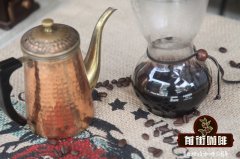Sensory taste | whether the flavor in coffee depends on drinking or smelling.

When we are taking sensory lessons, we are arranged to smell dozens of small bottles full of fragrance, and are asked to try to remember what we smell. The association and memory searched by the brain will remind us of the fragrance of every bottle we have smelled. Sometimes it's a straw, sometimes it's a bottle of syrup. Later we found that the nose became accustomed to searching for the aroma in the air, thinking of the aroma of straw or caramel when walking in the dark and quiet streets.
Science has proved that 80% of the smell we can recognize comes from the smell we smell. Our taste buds can only distinguish between sweet, sour, bitter, salty and delicious taste, while the rest of the taste is actually distinguished by our sense of smell.
For any coffee roaster, "coffee nose" is a necessary training tool. Due to different regions, we are very strange to many of the aromas mentioned in coffee, such as cedar, blackcurrant and so on. After the French Jean Lenoir's wine tasting tool Le Nez du vin was launched, it met the needs of coffee lovers and professionals, and then launched this Le Nez du Caf é coffee nose, which is specially used to train coffee aroma. Once launched, it is also favored by coffee lovers and professionals all over the world.
How to use it?
There are two ways to use scent bottles. One is to read the corresponding entries according to the instructions, train your sense of smell with each fragrance bottle introduced in the book, and try to remember as much as possible of the smell you smell.
The other is the deductive method: smell first and try to identify the aroma in each scented bottle. Is it wood? Or is it acidic? Is it metal? Or the smell of chemical medicine? This method is more effective and more interesting.
Why is the smell of the bottle different from that of the usual impression?
The smell in the fragrance bottle developed by the French is mostly derived from the smell of something common in Europe, and the same substance in China has the same name, but the smell is very different.
After the coffee nose is opened and used for a period of time, the smell may undergo oxidation, loss and other changes. For example, the smell of malt may slowly become the taste of rice wine because it has been kept for a long time. In the case of poor preservation, smelling the incense bottle is very easy to cause pollution.
The solvent that dissolves the odor has a certain odor.
The smell of some things is synthetic, and the smell in the synthetic scent bottle can only choose one of the typical smells, which may not be so real and distorted.
A supplement from the perfumer working in France: if the smell is cherry mango, because there is no natural raw material, it is a deductive smell, which is definitely different from the natural smell; even if it is a natural raw material, the smell and the real smell will be very different, because the smell in the fragrance bottle made by various means is not the same as the natural aroma.
Daily taste and smell training can be done by eating more fruit and smelling fruit aroma. For more in-depth taste training, compare dry, wet and flavor by smelling incense bottles and freshly ground coffee powder. If you smell the incense bottle too much, you will get dizzy.
Can first smell the lid, and then smell the oil, swing left and right so that the nasal cavity fully feel the smell, contrast smell. This can deepen the ability of discrimination. However, no matter what kind of scent bottle, frequent practice is bound to improve the ability of olfactory discrimination.
Important Notice :
前街咖啡 FrontStreet Coffee has moved to new addredd:
FrontStreet Coffee Address: 315,Donghua East Road,GuangZhou
Tel:020 38364473
- Prev

The alcohol thickness of coffee is low. How to improve the alcohol thickness of coffee when brewing?
The alcohol thickness of coffee is low. How to improve the alcohol thickness of coffee when brewing? BODY is the taste on the tip of the tongue when we drink coffee, and it is also the mellow thickness we mention in the mouth. BODY refers to "the weight of a drink or the fullness felt by the taste buds." But BODY is not some kind of iconic taste that we can taste, but a feeling. Its existence will affect
- Next

Ethiopian Coffee | Star of Africa-introduction to G1 Flavor of Yega Xuefei Peach
Ethiopia Star Yirgacheffe Washed Gmur1 Star of Africa-Yega Chuefei Peach G1 Variety: native species Heirloom Grade: GMel 1 production area: Yega Xuefei Yirgacheffe altitude: 2000 ~ 2050 m Refining method: washing method reference flavor: berries, citrus, Darjeeling black tea, delicate acidity, peach sweet African Star is a famous Ethiopian coffee
Related
- Beginners will see the "Coffee pull flower" guide!
- What is the difference between ice blog purified milk and ordinary milk coffee?
- Why is the Philippines the largest producer of crops in Liberia?
- For coffee extraction, should the fine powder be retained?
- How does extracted espresso fill pressed powder? How much strength does it take to press the powder?
- How to make jasmine cold extract coffee? Is the jasmine + latte good?
- Will this little toy really make the coffee taste better? How does Lily Drip affect coffee extraction?
- Will the action of slapping the filter cup also affect coffee extraction?
- What's the difference between powder-to-water ratio and powder-to-liquid ratio?
- What is the Ethiopian local species? What does it have to do with Heirloom native species?

